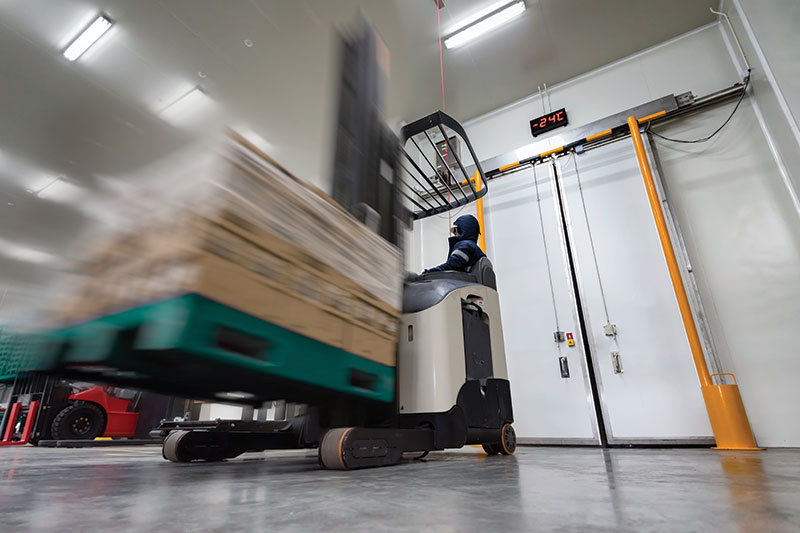All those frozen foods, subscription meal kits, and refrigerated foods and beverages that U.S. consumers increasingly buy, along wit...
All those frozen foods, subscription meal kits, and refrigerated foods and beverages that U.S. consumers increasingly buy, along with pharmaceuticals that need to be kept cold, equate to a need for more cold storage warehousing. Analyst firm Grandview Researchpegs the cold storage warehousing sector to expand at a compound annual growth rate of 13.5% from 2021 through 2028.
Some cold storage DCs may opt for automated storage and retrieval systems or other automation to minimize the need for lift trucks. But for many cold storage DCs, electric lift trucks are relied upon to handle goods.
Cold storage is a challenging environment because of the way the cold negatively impacts the normal capacity of a conventional lead acid battery and issues related to condensation when trucks move between cold storage and ambient parts of the facility for battery swaps and charging.
![]()
Lithium ion (Li-ion) batteries present an opportunity to reduce costs and improve productivity for cold storage DCs because Li-ion batteries support rapid opportunity charging instead of battery swaps, explainsRobin Schneider, director of marketing at Green Cubes Technology Corp., a manufacturer and supplier of lithium power systems for OEMs and enterprise customers. By using integrated battery heating within Li-ion batteries, Li-ion power doesn’t experience the cold temperature capacity loss like a lead-acid equivalent, she adds.
These Li-ion advantages, and others like minimal maintenance, add up to more value-added time for lift trucks and operators. “It’s all about the efficiency of the operators and greater value from the equipment,” says Schneider.
Lithium batteries carry a significantly higher sticker price than a lead acid battery equivalent, but payback is strong for multi-shift operations in which the advantages of opportunity charging, including needing just one battery per truck, accumulate more quickly, Schneider says. Eliminating swaps also brings other benefits, such as no need for a battery room, which recovers warehouse space, and no strains of lifting heavy batteries during swaps.
While lead-acid batteries can perform adequately in cold storage for lighter use scenarios, generally speaking, going with lithium means you only need one battery per lift truck, and time spent on battery swaps and maintenance is eliminated, making the Li-ion attractive for 24/7 cold storage. However, adds Schneider, some other, less well-known Li-ion features can help smooth the transition.
For one, the integrated heating elements that are part of a Li-ion battery means opportunity charging can take place inside of cold storage, which reduces condensation concerns. Some facilities place the Li-ion charger units just outside of cold storage, but run the cables inside to a spot where trucks are parked for opportunity charging, says Schneider.
Li-ion batteries have integrated electronics that allow for remote monitoring using Internet of Things (IoT) technology, which Schneider says allows for central, Web-based oversight of how batteries are being used and charged.
“The electronics inside the battery actually monitor every single cell in real time, communicated via IoT technology,” says Schneider. “This presents a way to remotely monitor the batteries to make sure each battery is being utilized optimally, and that operators are charging them appropriately. And not only can it help with charging practices, it can be used to lower costs, because the trends may show that an operation doesn’t need all the battery capacity it thought was necessary, and it may show that one battery is used continuously, while others are being under-used.”
Analyst firms predict significant gains for Li-ion batteries over the next several years, but for individual operations, it usually isn’t a hard cut-over from all lead acid to all lithium, says Schneider. Companies often make a phased switch, as conventional lead acid batteries reach the end of their life.
“Some of our customers have specifically assigned one of their best operators to be the first operator to trial lithium, to help with a smooth transition,” says Schneider. “Ensuring opportunity charging recommendations are followed is also a great use for IoT monitoring of the batteries—to see who’s following the bast practice and who isn’t.”







 粤公网安备 44010602003952号
粤公网安备 44010602003952号